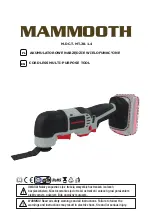
12
EN
PROPER USE
The device is intended for sawing, cutting and sanding.
The preferred materials on which the device can be used are: wood, plastic, drywall-
ing, non-ferrous metals, fixings (e.g. nails, screws) and wall tiles. It is particularly
suitable for working close to edges and precise work. Any other use or modification to
the device shall be considered as improper use and could give rise to considerable
dangers. We will not accept liability for loss or damage arising from improper use.
Not suitable for commercial use.
SAFETY INSTRUCTIONS AND WARNINGS
The equipment complies with the safety regulations required for electrical equipment.
Read through the instructions for use before starting up the equipment.
Improper use can lead to personal injury and property damage.
Persons, who are not familiar with the instructions, may not operate the equipment.
Keep the instructions for use in safe custody. Children and youths are not permitted
to operate the equipment.
GENERAL SAFETY INSTRUCTIONS FOR POWER TOOLS
WARNING!
Please read all safety notes and instructions. Failure to comply with the safety notes
and instructions can lead to electric shock, fire and/ or serious personal injuries.
Keep all safety notes and instructions for future reference. The term “electric tool”
used in the safety notes refers to powered electric tools (with power cord) and to
cordless electric tools (without power cord).
1) Workplace safety
a) Keep the workplace clean and well lit. Failure or unlit workspaces can lead to
accidents.
b) Do NOT use the power tool in an environment, where there is danger of
explosion, such as places with flammable liquids, gases or dust. Power tools
produce sparks, which could ignite the dust or vapors.
c) Keep children and other persons away while the power tools are in operation. In
case of distraction, the operator might lose control over the tool.
2)Electric safety
a) The connector plugs of the electric tool must fit into the power outlet. The
connector may not be modified in any way. Never use adaptor connectors
together with power tools with protective earthing. Unmodified connectors and
suitable power outlets reduce the risk of electric shock.
b) Avoid body contact with earthed surfaces, such as pipes, heaters, hearths and
refrigerators. If your body is grounded, there is an increased risk in case of
electric shock.
c) Keep power tools away from rain and moisture. If water enters a power tool,
there is an increased risk of electric shock.
d) Do NOT misuse the cable to carry or suspend power tools, nor to unplug the
connector from the power outlet. Keep the cable away from heat, oil, sharp
edges or moving parts. Damaged or entangled cables increase the risk of
electric shock.
e) When using a power tool outdoors, only use extension cables which are suitable
for outdoor use. Using an extension cable, which is not suitable for outdoor use,
increases the risk of electric shock.
f) If the usage of the power tool in a wet environment is unavoidable, use a
residual current device (RCD). The use of an RCD reduces the risk of electric
shock.
Summary of Contents for M.DC.T.MT.20.1.4
Page 2: ...2 1 2 3 4 5 8 7 7 6 6 B1 B2 B3 1 2 ...
Page 3: ...3 B4 2 B4 3 B5 B4 1 ...
Page 20: ......






































